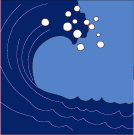

Goals:
1. Students will be introduced to ocean waves.
2. Students will enhance mathematical skills in the area of measurement.
3. Students will expand knowledge of the ocean and waves via the internet.
4. To connect curriculum to chapter six of Blue Skin of the Sea.
Resources:
1. Rulers
2. Internet capable computers (one per every two students)
3. Pencils
4. Blank sheets of paper
5. Student activity sheet
6. Internet site: http://www.oceanweather.com/data/plus000.html
Time:
This activity is divided into two sections. The first section will take approximately 10-15 minutes. The second part of the activity will take 45-50 minutes. The entire time allotment for this full activity is one hour.
Procedure:
Part One:
1. Discuss ocean waves as a class by asking students what they know (their background knowledge on the subject) Reiterate key points such as: common features (i.e. height and distance), and the role of the wind in the creation of waves.
2. Ask students to take out a blank sheet of paper. On this paper each student will be asked to draw their own wave with two crests like this:
Then do the following (this should be written on the board):
1. Label the two highest parts of the wave the "CREST."
2. Label the lowest part of the wave the "TROUGH."
3. Figure out the height of your wave (distance from trough to crest) if one inch equals
ten feet.
4. Figure out the length of your wave (distance from crest to crest) if one inch equals
eight feet.
5. Draw an arrow to show which way the wind is blowing your wave.
Part Two:
1. Ask students to pair up and assign each pair to a computer.
2. Students will log-on the Internet and locate the web site address http://www.oceanweather.com/data/plus000.html.
3. Once the Internet site has been accessed the students will observe the wave height map and study the various heights of waves around the world.
4. After studying the various heights in different areas, students will record these heights and locations around the world making reference to any differences and/or similarities and compare to those heights of waves in Hawaii. Students are encouraged to hypothesize as to why these differences or similarities are apparent.
5. Once observations and records have been made, each pair of students should graph their results. These graphs should show the height of the waves and the different coastal regions at which they occurred.
6. As a class discuss students' different hypotheses regarding similarities and differences. Make reference to cause of waves and relationship to wind and surface currents. Record these findings on the board for all students to note.
Assessment:
1. Students will be asked to hand in sheets from both parts of the exercise (Criteria for success = Completion of two activity sheets -- see rubric.)
Curricular Strands and Major Concepts:
1. Math - measurement, graphing
2. Science - hypothesizing the nature of waves
Possible Extensions:
1. Discuss the effects of waves in various regions of the world in terms of recreation,
etc.
2. Ask students to brainstorm and create an actual wave (to-scale) artistically.
3. Have students explore other related web sites.
Go to Water Danger
Go to Postcards from Hawaii
Go to Schdule of Lessons